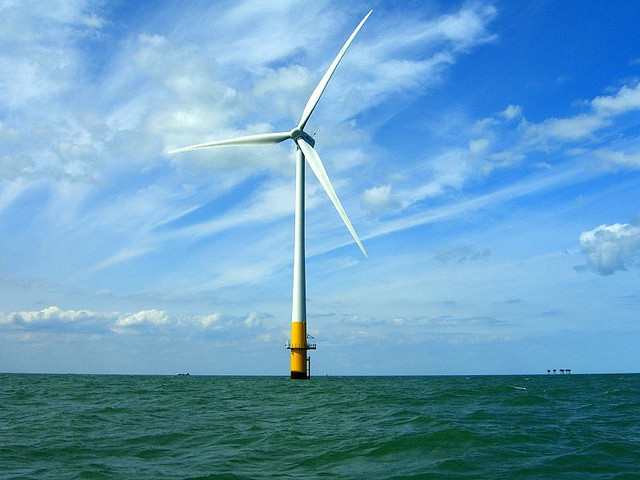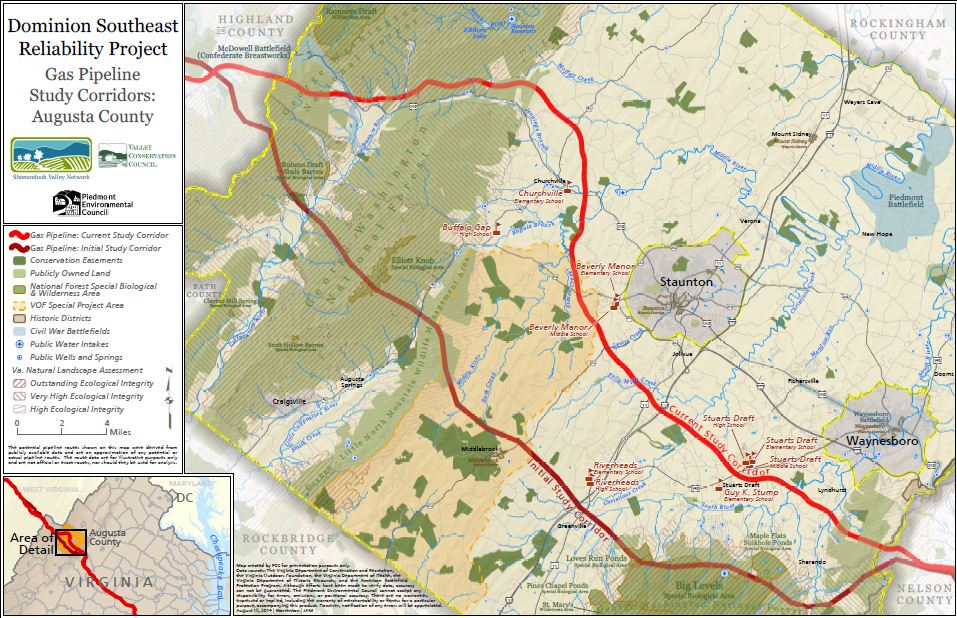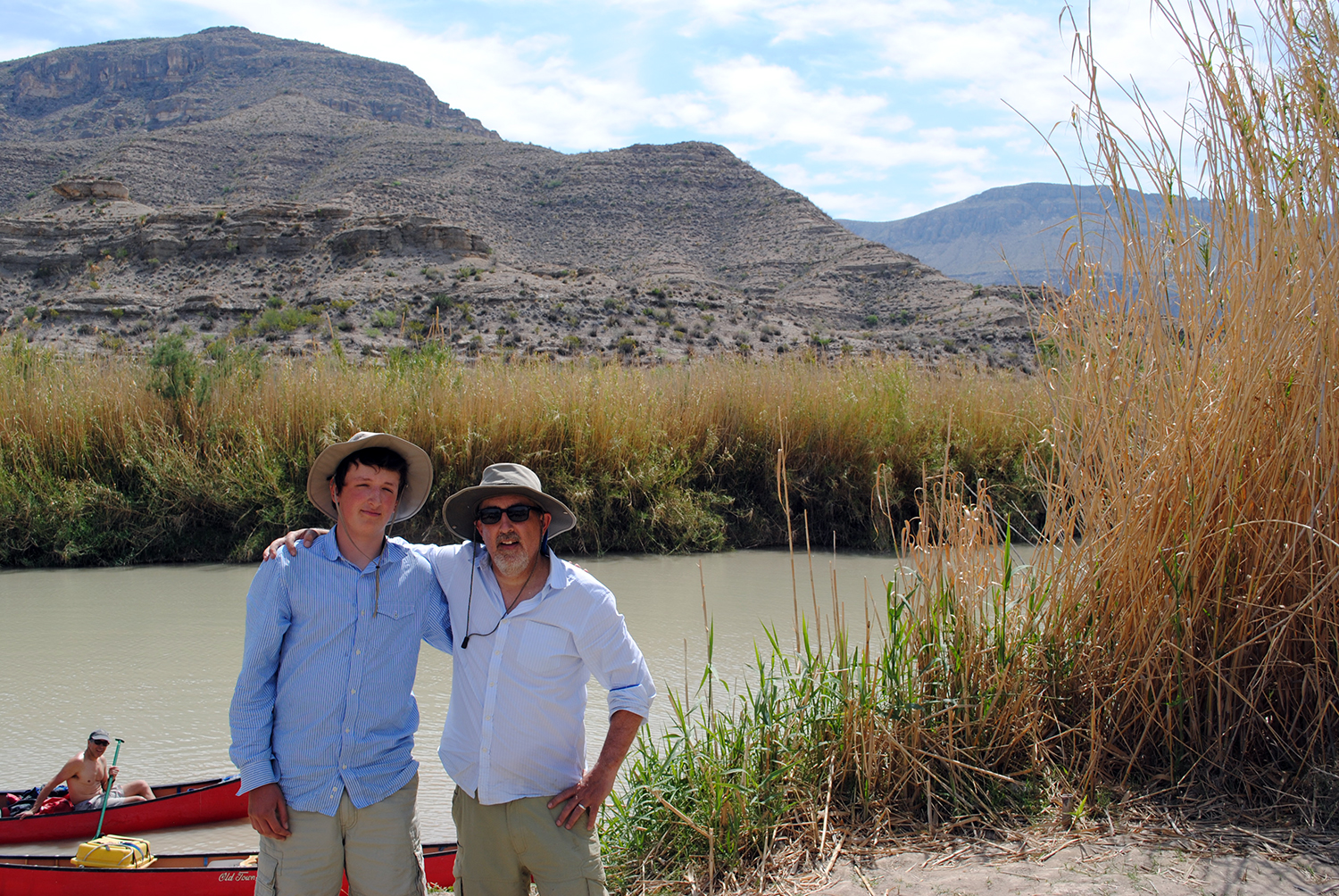This is a feature story in the summer issue of Orion magazine.
Sometimes travel is mandated, sometimes it is endured, but often it is undertaken for the sheer pleasure of seeing new places or visiting old friends. Sometimes we travel on foot, sometimes by plane, sometimes all it takes is a book or a good imagination to carry us away. What does travel mean, and how does it shape the course of a day or a lifetime? This spring’s double issue of Orion includes a special section exploring the idea of the journey, and we’re pleased to share one of the features with you here. To read the full special section, six features in all, subscribe to Orion and let the journey begin.
ABOVE THE ROCK canyon wall, the sun winks into morning view, drowsy and golden. The light pours onto the mute Rio Grande, soon finding our tent just yards from the bank. The slanting rays gradually find the sleeping face of my son, Sasha.
He’s fifteen years old. Not quite a man, but almost. We’ll be visiting colleges this time next year. He’s not a boy, either, although he looks consummately boyish in the innocence of slumber. I see the Little Leaguer in his face, and the kindergartener. In sleep we catch the last youthful poses of our children.
And at this moment, I wonder yet again why I brought Sasha to this wilderness place. Part of the answer is simple. I’ve traveled the world—the Amazon, the Serengeti, the Alps—and for me this is the most haunting and beautiful landscape on earth. We are in absolute backcountry: the Chihuahuan Desert canyons of “Big Bend Country,” literally that giant bend of the Rio Grande that separates west Texas from northern Mexico. The same sun washing over Sasha’s closed eyes is rousing the cliff swallows into song two hundred feet away. Around us, a million desert flowers go all electric in late-March bloom—red ocotillo, purple verbena, the magenta blossoms of cholla cacti. In the riverbank shallows, a longnose gar sloshes though the willow grass, hunting frogs.
Quietly, I slip out of the tent and catch a glimpse of a desert hawk winging hundreds of feet overhead, above the canyon. From up there, that hawk can see the nearby Chisos Mountains to the northwest, towering to nearly eight thousand feet with the deep-green cover of alpine woodlands. Below the peaks, that hawk can see the vast expanse of desert floor, all cactus and scrub, spreading north, south, east, west. And arching through it all is the pale green ribbon of the Rio Grande. But what that hawk doesn’t see are very many human beings.
I discovered the place fourteen years ago by accident. A newspaper editor asked me to visit Big Bend National Park, the twelve-hundred-square-mile jewel on the Texas side. The editor’s question: Why do so few Americans visit this most lovely of places? The reporter’s answer: It’s at the end of the earth, not on the way to anywhere, and surrounded on three sides by harsh and hostile Mexican desert.
But it’s beautiful. Shockingly so. And therein lies the problem in bringing my son—still-sleeping Sasha—to this place. It seems almost cruel. So many of the living things we’re here to celebrate, all across this landscape, are stressed out, dying, or migrating away from here. Like politics, all global warming is local. By roasting our common atmosphere with greenhouse gases, we bring chaotic change to regional ecosystems like the Big Bend region. Here scientists and fifth-generation ranchers and native people all tell the same story: unimaginable recent heat waves, freakish cold snaps and, above all, drought.
Just since I was last here—when Sasha was in diapers back home in Maryland—the place has changed. The pinyon pines in the Chisos range had not yet experienced “mass mortality” due to chronic lack of water. And the lechuguilla, a signature species of the desert, had not yet been flash frozen in huge numbers during the unheard-of cold spell of 2012. When Sasha is my age, fifty-one, this ecosystem will almost certainly be a distant memory, barring some global clean-energy miracle in the next few years, a rescue that seems less likely with each passing month of international inaction and domestic denial. So I struggle: Is this healthy? Is it right what I’m doing here, bringing Sasha to this place?
That morning in the canyon light, I’m bird-watching from the riverbank when the brightening day finally wakes up Sasha. “Hey, what’s for breakfast?” he asks. I hear his sleeping bag unzipping, his teenage voice turning to his favorite teenage subject: food. “Eggs and tortillas,” I say. “Outstanding,” comes the reply.
Within an hour we’ll be in a canoe, paddling through this still-rich land where the lechuguilla and pinyon pines are trying their best to recover and the roadrunners and tarantulas and mountain lions are all still here in good numbers, despite recent climate shocks. The Big Bend region, like the Amazon rainforest and the Great Barrier Reef, is an incomprehensively vast ecosystem still teeming with the life of the Holocene and our nearly twelve-thousand-year run of stable climate. Over 450 species of birds—more than in any other U.S. park—still live or pass through Big Bend National Park.
But we’re not voyeurs here, drawn to that shortsighted product of the global travel industry, see-it-while-you-can tourism. We’re here to see it, yes. While we still can, yes. And to bond in the delights of desert camping. But for me there are deeper, more elusive motivations. I have come to the place I love most in the world, with the person I love most, in order to . . . what? Apologize? Ask for forgiveness? Find some new hope in an unexpected fresh insight? All of the above? What, basically, do we say to our kids in the face of astonishing loss in the natural world? How much of that loss do we even want them to know about, to discover and love, as it changes and exits? What do we owe our kids? What do we owe these places? How do we even talk about all this?
WHEN SASHA WAS four years old, in 2001, I walked away from a twenty-year journalism career to become a full-time activist on global warming. The transition was not easy for him or me. I launched a nonprofit organization, raised money, hired staff, and worked nearly nonstop. Frequently reporters would call me at night or on weekends to discuss the latest terrifying scientific study on Arctic ice melt or rising storms. More than once I hung up the phone only to finally notice my little boy, fire truck in hand, looking up at me from somewhere in the room. “Are we all going to die, Daddy?” he’d ask.
“No way,” I’d say, swooping down for a hug. “No way. We’re going to fix this thing, I promise.” And off he’d go, building another Lego house, with windows and chimneys and always—always—lots of solar panels on the roof, just like our house. He assumed all homes had solar power. He assumed all dads talked on the phone about the end of the world, and then said not to worry.
It was a schizophrenic time, those early days of parenting and climate activism. I tried to manage Sasha’s relationship with nature, discouraging him from watching in-depth nature programs on TV, not wanting him to fall too much in love with all that. But we also hiked and camped and fished, a lot. I took him to the woods whenever I could. It’s my passion. And all his life Sasha heard me talk about Big Bend country. About this desert ideal in faraway Texas, and how I was going to take him there one day.
And then that day came. Sophomore year of high school. Spring break. Better go now before girls and college and career intervene. So we loaded up the backpacks, bought carbon offsets for the long trip, and boarded a flight at Reagan National. New sunglasses dangled from straps around our necks. High above the plains of central Texas, however, with nary a cloud below our plane, I realize something: I don’t have a plan for unspooling the big messages I had assumed—and hoped—would come from this trip. Thankfully, they began unspooling themselves.
“Look at that,” Sasha says, pointing to hundreds of pumpjack oil wells spread thousands of feet below us.
“Nineteenth-century energy,” I tell him.
“And what’s that?” he asks, pointing to an apparent matrix of rocket launchers.
“Fracking for gas,” I say. “Twentieth-century energy.”
And then, further west, I spot the series of awesome white lines, full of spinning giant blades. “Your century, Sasha,” I say, as the wind farms pass below our plane, working with haughty gracefulness in the Texas breeze. “Yours.”
We finally land in El Paso, along the northern edge of the Chihuahuan Desert, and head southeast by car. Tiny ranch towns soon give way to nothing but creosote bush and towering yucca, dust devils and lost burros. When the two-lane state roads finally run out five hours later, we enter Big Bend National Park. And it’s everything I remember.
“Did I exaggerate? Did I exaggerate?” I ask my son. He’s too busy shooting photos to talk much. The camera spoke softly, click after click, as giant agave plants float into view in golden, brittle poses. Then come the arroyos, violently beautiful in the distance, carved by a million flash floods. Then the Chisos Mountains, phantomlike, forested, painted in shadows. Click. Click. Click. And then swaths of red-blooming Indian paintbrush, punctuated with javelina tracks and the den doors of a strange desert rat that miraculously never, ever, drinks water. “You did not exaggerate,” Sasha says.
The camera’s clicking is a memory cue for me, reminding me of a speech Bill McKibben gave in 2005, addressing a group of climate activists gathered at Middlebury College. “Fight like hell,” Bill told us. “But be a witness, too. Go see the whales, the rainforests. There’s no guarantee we’ll save them all. Memorize this great world, the one we were born into. Tell others in the future. Their mistakes might be fewer if they know the greatness we once saw.” This had always been a central if unspoken part of this trip to Texas, of course. And it explained most of the trips to the woods during Sasha’s childhood. Be a witness, my child. Don’t forget these things.
And so on our first full day at Big Bend National Park, we race to the top of the highest mountain, Emory Peak, and toss off our backpacks. There, from nearly eight thousand feet, we look down on an absolute kingdom. It tumbles and flows below us, down from a crown of pinyon pines to a robe of scrub oaks and desert flowers to a labyrinthine floor of cactuses stretching to the Rio Grande and off into Mexico. We are at the summit, Sasha and I, at last, where mountain lions roam amid rare Carmen Mountain white-tailed deer.
And if only it had ended right there—if only the story had been exclusively about life that day, and not also death. But the path back down the mountain does not lie. It meanders past bright-orange metal signs put there by rangers: FIRE DANGER EXTREME and HIGH RISK OF WILDFIRE. Sasha photographs these too. Click. Click.
The first decade of the twenty-first century was one of the driest in Texas since record-keeping began. And 2011 was the driest single year of all for many parts of west Texas. Like a vise, the trend of severe drought, intensifying over the last half century, is clamping down here. Scientists say rising temperatures are to blame. The hotter it gets, the greater the evaporation, sucking moisture and life right out of the land.
I hear the sound of cracking twigs and crumbling pine bark under our boots as we walk through our first long stretch of dead woodlands that day. It is worse than a graveyard. The bodies are unburied: bleached pinyon torsos countless and eerie all around us. They fill narrow valleys and cover the tops of foothills in vast patches amid the still-green survivors. The dieback of these pines is happening all across the American West, affecting everything from black-chinned hummingbirds to black bears. At the edge of one maze of dead trees, we break for water. I had worked up a little speech for years. “Remember when you were little,” I say to Sasha, “and how I always told you we were going to solve global warming?”
“Yeah,” he says. I pause and then tell him, for the first time, about McKibben’s speech. Sasha is ready, I figure. Fifteen years old. “The wind farms just aren’t coming fast enough,” I say. “We’re going to lose a lot on this earth.”
But like Santa Claus and sex, we both know he’s understood the truth long before. It’s good to have it out of the way, nonetheless. “Yeah, I know,” he says, packing up his camera, ready for the final hike down to camp. “And I’ll remember,” he says. “I’ll remember.”
SASHA IS A WONDERFUL son: honor student, junior varsity baseball pitcher, Eagle Scout. Best of all, right now, he’s totally into this intense and adventurous trip west with his dad. But he’s still a teenager. Ten months earlier, right before turning fifteen, he told his mom and me not to bother getting him a birthday present if it wasn’t an iPhone. If we loved him, he said, we’d get him one. So we got him an iPhone.
After sunset, lying on our backs below a brilliant desert night sky, billions of stars above, the hallelujahs fill my ears as if from a choir. Sasha and I are side by side, stunned into silence by the celestial display. And his phone has no signal. None. Blessedly. For the entire week. Same with mine.
So we are able to float, undisturbed, into the infinity of outer space. That’s what it feels like on a moonless night in west Texas. It’s not stargazing here. A dense curtain of brilliant dots is pulled from horizon to horizon, each dot saying, “Touch me. Touch me.” At night, lying here on your back, you are in outer space. We spy a blinking satellite. We find Saturn, Orion’s belt, and Cancer. Ursa Major leads us to Polaris, the North Star. “Whoa!” I say, pointing to another impossibly long shooting star.
It’s midway through our journey, and this has always been part of the plan: to show Sasha the best star display in America and perhaps the world. It’s a counterweight—timeless, cosmic—to the earthbound challenges and intermittent sadness of this one desert expanse on a tiny planet in a lonely solar system. I can feel the cool sand against my back. “Is it bad,” Sasha asks, “that I wish I were watching March Madness basketball right now?” He pulls out his phone. “Don’t you wish we could know the scores?”
IF YOU WANT to take the long view of matters here and yonder, then Ten Bits Ranch is one of those word-of-mouth places worth wandering into. A self-styled eco-refuge just outside the western border of Big Bend, it’s run by two geologists who are also amateur paleontologists and off-the-grid enthusiasts. Solar panels power the whole ranch, including the lamps in the cantina that light up an amazing collection of dinosaur bones under glass. There are vertebrae from duck-billed hadrosaurs and tail bones from mammoth Jurassic crocodiles, all found on the five hundred acres here. We’ve come to Ten Bits to wash up between camping trips and to learn about low-carbon life in the desert. But mostly we’ve come to explore a mysterious cliff dwelling on the property, used by Apache, Comanche, and older Archaic tribes for millennia.
It’s another cool, blue-sky morning in the desert when we leave our cabin, walking past bleached cattle skulls nailed to fence posts. The ancient Indian settlement is a quarter mile away, up a gentle slope along the southern side of a low mountain. Our hearts are pounding as we scramble past the final few boulders and red-blooming ocotillo to arrive at this unmarked and little-visited place. The shelter is simple and primitive, consisting of a long, deep rock overhang. But evidence of habitation is everywhere, including cylindrical mortars in the rock floor, worn in from centuries of pounding grain with hand-held pestles.
We stand on the ledge, facing the distant Rio Grande, and imagine the people who once lived here. The south-facing overhang was for winter shelter, anthropologists believe, offering protection from the cold north wind. In summer, it would have been too hot here, too exposed to sun. I think of all those people. All those winters. They slept, daydreamed, argued, laughed, made love, belched, snored, and cried right here—for thousands of years, with only a crude shelter from wind, a bad shelter from rain, and no shelter from cold.
Reflexively, I begin looking for an arrowhead. I always do whenever I think I have any chance. I scatter small rocks with my toe. I peek under boulders. I talk while I hunt, trying to stay on message. “The thing is,” I say to Sasha, “this climate change we’re seeing worldwide is going to affect more than just plants and animals pretty soon.” His teenager impatience starts coming through. “You’re about to tell me life is going to get hard for all people soon, aren’t you?”
“Well, yes.”
“But that civilization will carry on somehow, even if it’s hard. These cliff dwellers endured under hard conditions.”
“Yes,” I say.
“Well here’s what I don’t understand,” he grumbles, standing on the ledge and pointing to Ten Bits Ranch in the distance. “See all those solar panels?” There were eighteen of them, polycrystalline, big, providing three kilowatts of power, enough to run a kitchen, lamps, a water well, iPods, all in the middle of nowhere. “Why,” Sasha asked, “can’t ExxonMobil just become the Exxon of solar? Can’t these companies make a profit building solar farms?”
“Yes.”
“So why don’t they do it and just get off of oil?”
“Because Exxon can make more money with oil right now. Bigger profits.”
“So this whole thing—Katrina, Sandy, drought—is about Exxon making slightly higher profits for a few more years until god knows what happens to the climate?”
“Yes.”
“Dad, how are you losing this debate?”
“We’re not losing it,” I say. “We’re just not winning it fast enough.”
“What’s it going to take?” he asks. “Just what in the world is it going to take?”
“I don’t know,” I tell him. “I don’t know.” I keep saying it. Until I stop saying it.
“Holy cow!” I shout. The stone in my hand is not an imposter this time. It’s not a mere triangle-shaped rock with coincidental sharp edges. It’s an arrowhead. Carefully worked. Chipped, flaked, pointed. I found an arrowhead.
THE WEEK, too soon, roams to a close as we head back toward El Paso, our dusty tent and backpacks stuffed in the trunk. I feel a restlessness lift from me. I’ve finally done it. I’ve taken my son to this place. And now I’ll never come back here again. I know it. Not me. I have my memories. I love those memories. Why risk them with another return?
“What?!” Sasha exclaims when I tell him this. He’s appalled. “You’re crazy not to come back. I’m coming back. And I’m staying longer. As soon as I can.” From the passenger seat, he’s shooting some final desert photos.
And then I see it in his face. He has the same bug I’ve had for a decade and a half, but in a different way. He just finished touring a beautifully imperfect place. A place in transition. But he’s not sad. He’s not bummed out, perhaps despite my best efforts. He has a different starting point than I do. Born in 1997, all he’s known is a fast-changing, impermanent earth. So the world seems less fragile to him, I think. More elemental. Rock, sky, sand, life. It will all be here whenever he returns. And, if pressed, I think he would call that hope.
















